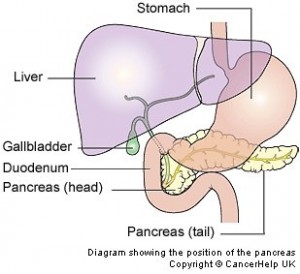 I wanted to clarify something for those who don’t make their own insulin anymore (people with various types of diabetes). The pancreas is the organ, or gland (or “glandular organ”), that produces insulin. This is part of its endocrine function (it also produces other hormones). The pancreas also produces digestive enzymes, which we need to properly digest our food, and this is part of its exocrine function.
I wanted to clarify something for those who don’t make their own insulin anymore (people with various types of diabetes). The pancreas is the organ, or gland (or “glandular organ”), that produces insulin. This is part of its endocrine function (it also produces other hormones). The pancreas also produces digestive enzymes, which we need to properly digest our food, and this is part of its exocrine function.
In people who have type 1 diabetes the pancreas stops making insulin (or at least not enough to keep the person alive without taking insulin – there is research showing that many people with type 1 still make a teeny tiny amount of their own insulin). In LADA, the pancreas makes some insulin, but it may not continue to do so forever, and people with LADA need to take insulin at some point. In type 2 diabetes, the pancreas continues to make insulin, but it is not used properly. In addition, the pancreas typically overproduces insulin for a while before the diabetes is detected, which can lead to burnout. Many people with type 2 diabetes end up needing to take insulin at some point – sometimes to augment what their pancreas makes and sometimes to replace it if the pancreas is no longer producing any insulin.
Here’s the catch: the pancreas is not dead! Many people jokingly (or not) refer to their pancreas as “broken” or “dysfunctional.” I’m ok with those terms. But “non-functioning” and “dead” just aren’t correct. I once heard a patient in a hospital being taught that their pancreas was dead and just “floating around in there.” Clarification: the pancreas is still working hard to produce those enzymes I mentioned earlier and maybe even some other hormones. Although the pancreas of someone with diabetes is most likely not meeting all of it’s job requirements, it’s not dead, and it’s not floating.
